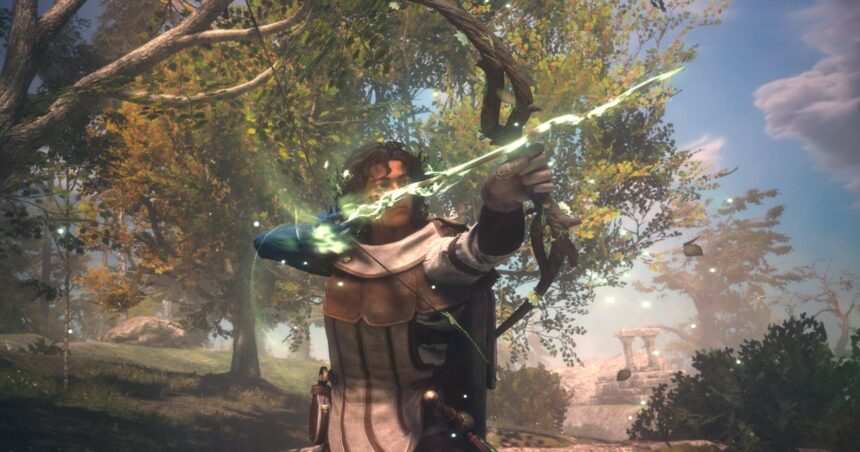Warframe has been a resounding success for Digital Extremes, continuing to grow in terms of both content and player numbers 12 years after launch. This does not, however, guarantee success for its next venture, Soulframe – a fact of which the company is all too aware.
Warframe was first released in 2013, when live-service games were a relative rarity rather than an omnipresent feature of the industry landscape. Now, a seemingly endless parade of such titles ruthlessly battle one another for an audience. Too many live-service games have been shut down too quickly, and too many developers have been laid off.
“It’s a different time,” says Digital Extremes president Sheldon Carter. “It’s a different way games are launched now. We decided to kind of go back to our roots a little bit.”
“What we’ve been doing with Soulframe is gradually building the game out. So we’ve been doing these preludes, which are just small snippets of the game. We’re letting more and more people in.”
Involving the audience in development is not a radical idea for Digital Extremes; rather, it is a sign of their respect for, and gratitude to, the community. Warframe was developed and released during a critical time for the company, when it was on the brink of collapse. Although some of the team weren’t convinced that a free-to-play title was the way to go, Warframe found an enthusiastic paying audience, which has only continued to grow over the years.
“Our ethos at DE is ‘build with the community’. If you’ve followed us for any amount of time, that’s kind of our thing. And so we really wanted to follow that with Soulframe.”
Different framing
Where will Soulframe’s audience come from? Digital Extremes already has access to an active userbase in the millions with Warframe, but tapping into this to any great extent would result in audience cannibalisation that presents a danger of greater resource expenditure for negligible gain. Carter is confident that the points of difference between the two games are strong enough to avoid this.
“I think the games are, in a way, complete opposites of each other. You’ve got Warframe, which is really fast, sci-fi, twitchy at a level. Soulframe is slower, romantic, and a fantasy. And so the place where those two worlds collide, I don’t really see it, I don’t think we see it.”
With an audience as big as Warframe’s – over 80 million players, including one million downloads on Nintendo Switch within the first three weeks of its 2018 launch alone – some degree of audience crossover, Carter concedes, is inevitable. Yet he remains comfortable that this crossover will not represent a significant proportion of the Soulframe player base.
“I mean, it has ‘frame’ in the title, right? Soulframe, Warframe, there is the brother-sister relationship between the two. But consciously we are making two separate games, certainly.”
“The Soulframe audience might be that person that grew up playing Zelda, really likes Elden Ring, but finds it too hard; and that audience is, I think, quite a bit different than the Warframe core audience.”
.jpg?width=1920&height=1920&fit=bounds&quality=70&format=jpg&auto=webp)
He points out that Soulframe is about getting back to nature, with gameplay that involves freeing animals and walking vast environments, which he notes is a marked change from the ‘bullet jumping’ and parkour of Warframe.
“So I think the pace of the games, the themes of the games, they’re kind of yin and yang to each other. I don’t think it’s impossible that people that love Warframe would love Soulframe. I think that there’s a place for that, but I do think Soulframe’s net is cast towards a different type of player than is normally captured by Warframe.”
This seems to explain why there have been – so far, at least – no in-game events or messaging of any kind in Warframe to promote Soulframe (although Carter does note, “never say never”).
Players who register on the Soulframe website are placed onto a waiting list for invites, although anybody who registered during this year’s Tennocon (Digital Extremes’ Warframe convention) was guaranteed a place. This influx of players will provide an opportunity for segmentation analysis to better understand the audience.
No money down
The preludes build has been running for about a year and a half. Despite this length of time, and despite the fact that Digital Extremes has recently reached the point where player accounts will no longer be reset, there is no monetisation for the preludes.
“This is true development,” Carter explains. “I think the other thing is that, unfortunately, in the industry there’s been the code of ‘pre-release’ or, you know, ‘games in beta’, that often those games are just released games, and so, the developer needs to make money.”
“And I totally get it and respect it, and that’s how it is. For us, the reverse is true, these preludes are true development milestones that we’re going through. So because that’s what they are, we need to have the flexibility to delete, to remove gear, to change it, to completely rebalance it. And I don’t think that’s fair to a player if you’ve paid for something, and then we totally change it, because we haven’t quite figured out exactly how the game is going to work for that specific thing.”
.jpg?width=1920&height=1920&fit=bounds&quality=70&format=jpg&auto=webp)
He notes that they could have driven through monetisation, but it would have involved “a lot of community management and a lot of player management.”
Involving players at such an early stage of development, and allowing them to experience the build at home at their leisure rather than in brief bursts of time in controlled playtest environments, has provided crucial insight that can only be gleaned from your audience. For a live-service title, the ability to interpret and act on feedback in this way prior to release – rather than scrambling to redevelop a public build and stem audience bleed – is invaluable.
“You have to look at the things that you’re doing, and reassess”
Sheldon Carter, Digital Extremes
“Last year at Tennocon was really a huge moment for us,” says Carter. “When [the community] saw what we did at Tennocon, they loved a lot of it, but they really came down pretty harshly on what we were doing so far with the combat, and the thing is, you have to get that type of feedback, and you have to look at the things that you’re doing, and reassess.”
Not despite, but because of Warframe’s continued success, Digital Extremes is being very careful with Soulframe, taking its time and listening to the community extremely closely. The financial comfort they only could have dreamed of in 2013 allows them to work at their pace, not that of the industry at large.
“So we’re proud of it. We’re proud that we’re evolving with the community. And you have that combination of the subjective feedback that you get from a community that’s in the preludes, [and] the complexity of our stats back end that’s telling us, for real, what people are doing. You combine that, you get a really clear picture of what’s resonating with people and what isn’t.”
The future
Soulframe has come a long way, but it’s still not quite ready for public release, as the central progression mechanics are still being tweaked and polished before being implemented into the preludes build. But once the prelude stage of development is over and a public build is released, what will that look like? How will Soulframe find its audience, and how will its audience find Soulframe?
Again, it comes down to breaking down the barrier between developer and player.
“For us, the game is about community. I mean, hey, we’ll do the marketing beats that we need to; but for us, go to market is more about seeking the community. Maybe Soulframe would fit in at, like, Gen Con. It’s got the audience that has no idea that we exist, that I think would love this type of game. And so it would be going out to those shows while doing all the traditional marketing at the same time, and trying to build that community player base, before we did anything even bigger.”
.jpg?width=1920&height=1920&fit=bounds&quality=70&format=jpg&auto=webp)
The plan is for Soulframe to grow slowly but strongly, rather than release with an explosion of marketing and an expectation of instant, record-breaking revenue.
“That’s just our way,” Carter affirms. “Warframe didn’t become an overnight success. It was years of building, and I think we know how to work that way, we have the right people who have done it that way.”
“For us, it’s more about the slower build. I don’t see any reason why we would treat Soulframe differently than Warframe in that regard.”
With a heavy emphasis on community both before and after launch, Digital Extremes’ ambition for Soulframe is that if you code it, they will come.





